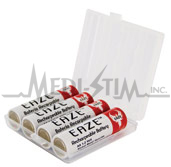Medi-Stim's Guide to Using Batteries
Since most TENS units and portable electrotherapy devices operate on batteries, it is important to know the various characteristics of batteries and how to properly take care of them to ensure the most power and life from each battery. The higher the amplitude and frequency settings used, the shorter a battery will last. Most batteries are made up of individual cells that each hold a charge. The power of a battery is determined by how many cells there are inside a battery and how much charge they hold. |
 |
| Heavy Duty batteries are made of carbon zinc or zinc chloride. These provide sufficient amount of current to operate most stimulators, and are very inexpensive compared to alkaline batteries. A 9-volt heavy duty battery in a TENS unit will generally last 8-14 hours on normal settings.
Alkaline batteries provide a stronger charge and last longer than heavy duty type batteries. They are also safe for the environment when disposed. In TENS units, alkaline batteries generally provide between 12-18 hours of power. Alkaline batteries should not be recharged as the cells inside the battery can overheat and possibly explode.
Rechargeable batteries can be used instead of alkaline batteries for most stimulators.These can be recharged again and again for more frequent usage. Because they have a different cellular make-up than alkaline batteries and provide a different output of power, it is important to check if rechargeable batteries can be used with certain stimulators. In TENS units, they generally provide between 8-12 hours of power before needing to be recharged, depending on amplitude and mode settings. Two different types of rechargeable cells are available: Ni-Cad and Ni-MH. Charging times may vary, but usually require at least 14 hours.
- Ni-Cad Rechargeable batteries composed of nickel cadmium (Ni-Cad) must be properly charged and discharged for optimum power and life. Once the battery goes low, one must make sure to fully discharge any power that is left in the battery in order to get the most power back into the battery; otherwise, the battery will not recharge to its full capacity. Ni-Cad batteries also contain cadmium which is not safe for the environment if not properly disposed.
- Ni-MH Although Ni-Cad batteries are still used, nickel metal hydride (Ni-MH) rechargeable batteries require less care and are environmentally safe. These batteries do not contain cadmium, and better yet, they do not have to be totally discharged before recharging. They are a little more expensive than Ni-Cad batteries, but are worth it for the convenience.
Using high quality electrodes that conduct well will help batteries last longer, too. All batteries should be kept out of extreme hot or cold temperatures and stored in a cool, dry place. For rechargeable batteries, please be sure to follow the recharging instructions on the batteries or charger.
|